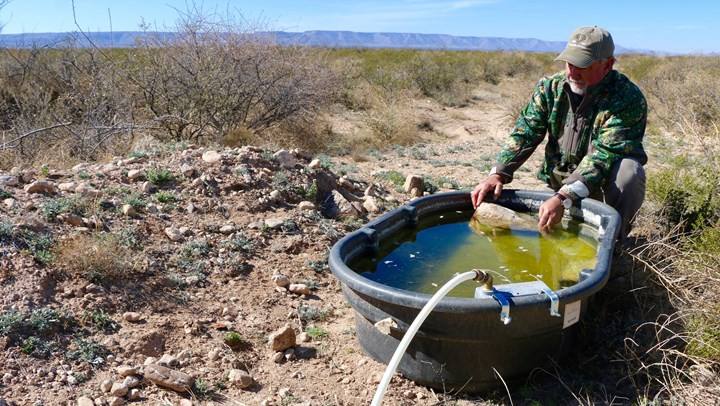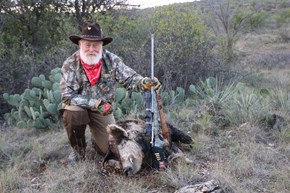
by Larry L. Weishuhn, wildlife biologist and outdoor TV host - Saturday, March 25, 2017

“The desert is a thirsty land! To improve habitat and perpetuate wildlife, simply add water … and then some rocks!” spoke a smiling Greg Simons, Texas hunter, wildlife biologist, outfitter and former president of the Texas Wildlife Association. “Because of livestock grazing, landowners have drilled water wells through the arid lands, then piped the precious liquid into troughs throughout their property for livestock and big-game species, primarily mule deer and pronghorn antelope. Water trough placement helps distribute grazing pressure and takes advantage of rangeland that otherwise might not be attractive to animals.”
As owner of Wildlife Systems, Inc., headquartered in San Angelo, Texas, Simons uses his experience to solve diverse wildlife and habitat management challenges. He is often called upon to help improve rangeland for wildlife, especially desert mule deer and pronghorn antelope but also for desert-dwelling game birds. “Stock tanks might hold water for a little while, but after rains quit they soon go dry. So we’ve learned how to take advantage of the water systems ranchers have set up for their livestock and increasingly for the wildlife that lives on their property.”
Simons encourages landowners to use water troughs, which are low to the ground so the water can be accessed by deer and other species. He explains the “float system,” which controls the water level, needs to be housed in a cage so it cannot be broken or accidentally manipulated by the animals using the trough.
“This system works well for big and medium sized animals, but does nothing for game birds or song birds. Birds can land on the lip of the trough, but the water is likely still a couple of inches or more below where they can get to the water to drink. To make water available to birds, we pile rocks in a corner of the trough. Birds can land on these and easily get a drink. By providing water to birds this way, we have increased not only our game birds, we have also greatly increased song and other bird populations.”
In some areas, larger open-water storage containers, locally called “pilas,” are used to make water accessible to birds with the help of 1-inch by 12-inch boards about 2-feet in length. Simons explains, “To keep these from interfering with water coming into or going out, attach a small chain, length determined by the depth of the water, to the bottom of board. Attach the other end to a cement filled 1-pound coffee can to hold the ‘watering board’ in place.”
These types of “watering access” for birds, he adds, can also be done in your backyard, or anywhere it might otherwise be difficult for birds to get water.
“Money paid to landowners for access to their property for hunting helps establish and maintain these watering facilities which, in turn, enhance and improve wildlife habitat for not only game animals, but non-game species as well,” said Simons. “Actually, the non-game species benefit the most!” Simons proudly adds.
■ ■ ■
About the Author
Legendary “Mr. Whitetail,” Larry Weishuhn, host and owner of DSC's "Trailing the Hunter's Moon," is one of the most popular and widely-recognized wildlife biologists and outdoor media personalities nationwide. Over the past five decades, he has authored multiple books and numerous articles on hunting and wildlife conservation. In his 2004 book, Trailing the Hunter's Moon, was named Foreword Magazine's Gold Book of the Year in the Adventure and Recreation category.
Over the past five decades, he has authored multiple books and numerous articles on hunting and wildlife conservation. In his 2004 book, Trailing the Hunter's Moon, was named Foreword Magazine's Gold Book of the Year in the Adventure and Recreation category.
A lifelong hunter, Weishuhn has long served as a featured speaker for the NRA and other organizations including Dallas Safari Club (DSC) and the Texas Wildlife Association (TWA), where he was one of three co-founders promoting science-based wildlife management, firearms and hunting. For more information, click here.
E-mail your comments/questions about this site to:
[email protected]
Proudly supported by The NRA Foundation and Friends of NRA fundraising.
